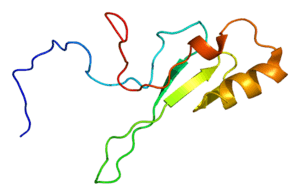MECP2 duplication syndrome
MECP2 duplication syndrome (M2DS) is a rare disease that is characterized by severe intellectual disability and impaired motor function. It is an X-linked genetic disorder caused by the overexpression of MeCP2 protein.
| MECP2 duplication syndrome | |
|---|---|
| Other names | X-linked intellectual disability-hypotonia-recurrent Infections syndrome |
 | |
| This condition is due to MECP2 overexpression | |
| Specialty | Medical genetics |
Signs and symptoms
Symptoms of M2DS include infantile hypotonia and failure to thrive, delayed psychomotor development, impaired speech, abnormal or absent gait, epilepsy, spasticity, gastrointestinal motility problems, recurrent infections, and genitourinary abnormalities.[1][2][3] Many of those affected by M2DS also fit diagnostic criteria for autism.[4] M2DS can be associated with syndromic facies, namely an abnormally flat back of the head, underdevelopment of the midface, ear anomalies, deep-set eyes, prominent chin, pointed nose, and a flat nasal bridge.[4]
Cause
M2DS is one of the several types of X-linked intellectual disability. The cause of M2DS is a duplication of the MECP2 or Methyl CpG binding protein 2 gene located on the X chromosome (Xq28).[5] The MeCP2 protein plays a pivotal role in regulating brain function. Increased levels of MECP2 protein results in abnormal neural function and impaired immune system.[4] Mutations in the MECP2 gene are also commonly associated with Rett syndrome in females. Advances in genetic testing and more widespread use of Array Comparative Genomic Hybridization has led to increased diagnosis of MECP2 duplication syndrome.[6] It is thought to represent ~1% of X-linked male mental disability cases.[7] Females affected by this condition often do not show symptoms.[4]
Diagnosis
Diagnosis is made based on genetic testing.[4]
Management
Treatment is supportive and based on symptoms.[4]
Epidemiology
The syndrome primarily affects young males.[7] Preliminary studies suggest that prevalence may be 1.8 per 10,000 live male births. 50% of those affected do not live beyond 25 years of age, with deaths attributed to the impaired immune function.[8]
History
M2DS was first described in 1999.[4]
In a Nature article published on November 25, 2015, it was revealed that researchers at the Baylor College of Medicine, led by Dr. Huda Y. Zoghbi, have reversed MECP2 Duplication Syndrome in adult symptomatic mice using antisense therapy.[9] Mice treated with an experimental ASO administered through the central nervous system had a reduction of MECP2 protein to normal levels and symptoms of hypoactivity, anxiety, and abnormal social behavior were resolved. Additionally, the seizure activity of the mice and abnormal EEG discharges were abolished. Initial studies demonstrated that reducing the MECP2 protein levels to the correct amount also normalized the expression of the other genes controlled by the MECP2 protein.
References
- "MECP2 duplication syndrome - Genetic and Rare Diseases Information Center (GARD) – an NCATS Program". rarediseases.info.nih.gov.
- Ramocki, Melissa B.; Peters, Sarika U.; Tavyev, Y. Jane; Zhang, Feng; Carvalho, Claudia M. B.; Schaaf, Christian P.; Richman, Ronald; Fang, Ping; Glaze, Daniel G.; Lupski, James R.; Zoghbi, Huda Y. (2009). "Autism and other neuropsychiatric symptoms are prevalent in individuals withMeCP2duplication syndrome". Annals of Neurology. 66 (6): 771–782. doi:10.1002/ana.21715. ISSN 0364-5134. PMC 2801873. PMID 20035514.
- Ramocki, Melissa B.; Tavyev, Y. Jane; Peters, Sarika U. (2010). "TheMECP2duplication syndrome". American Journal of Medical Genetics Part A. 152A (5): 1079–1088. doi:10.1002/ajmg.a.33184. ISSN 1552-4825. PMC 2861792. PMID 20425814.
- "MECP2 Duplication Syndrome - NORD (National Organization for Rare Disorders)".
- Reference, Genetics Home. "MECP2 duplication syndrome". Genetics Home Reference.
- "Van Wright Foundation". Van Wright Foundation.
- Van Esch, H. (2011). "MECP2 Duplication Syndrome". Molecular Syndromology. 2: 128–136. doi:10.1159/000329580. ISSN 1661-8777. PMC 3366699. PMID 22679399.
- Van Esch, Hilde (7 June 1993). Adam, Margaret P.; Ardinger, Holly H.; Pagon, Roberta A.; Wallace, Stephanie E.; Bean, Lora JH; Stephens, Karen; Amemiya, Anne (eds.). GeneReviews®. University of Washington, Seattle. PMID 20301461 – via PubMed.
- Sztainberg, Yehezkel; Chen, Hong-mei; Swann, John W.; Hao, Shuang; Tang, Bin; Wu, Zhenyu; Tang, Jianrong; Wan, Ying-Wooi; Liu, Zhandong; Rigo, Frank; Zoghbi, Huda Y. (25 November 2015). "Reversal of phenotypes in MECP2 duplication mice using genetic rescue or antisense oligonucleotides". Nature. 528 (7580): 123–126. Bibcode:2015Natur.528..123S. doi:10.1038/nature16159. PMC 4839300. PMID 26605526.
Further reading
- Samaco, Rodney C; Mandel-Brehm, Caleigh; McGraw, Christopher M; Shaw, Chad A; McGill, Bryan E; Zoghbi, Huda Y (2012). "Crh and Oprm1 mediate anxiety-related behavior and social approach in a mouse model of MECP2 duplication syndrome". Nature Genetics. 44 (2): 206–211. doi:10.1038/ng.1066. ISSN 1061-4036. PMC 3267865. PMID 22231481.
- Francesca Ariani, Francesca Mari, Chiara Pescucci, Ilaria Longo, Mirella Bruttini, Ilaria Meloni, Giuseppe Hayek, Raffaele Rocchi, Michele Zappella & Alessandra Renieri (August 2004). "Real-time quantitative PCR as a routine method for screening large rearrangements in Rett syndrome: Report of one case of MECP2 deletion and one case of MECP2 duplication". Human Mutation. 24 (2): 172–177. doi:10.1002/humu.20065. PMID 15241799.CS1 maint: multiple names: authors list (link)
- Chahrour, M.; Jung, S. Y.; Shaw, C.; Zhou, X.; Wong, S. T. C.; Qin, J.; Zoghbi, H. Y. (2008). "MeCP2, a Key Contributor to Neurological Disease, Activates and Represses Transcription". Science. 320 (5880): 1224–1229. Bibcode:2008Sci...320.1224C. doi:10.1126/science.1153252. ISSN 0036-8075. PMC 2443785. PMID 18511691.
External links
| Classification | |
|---|---|
| External resources |